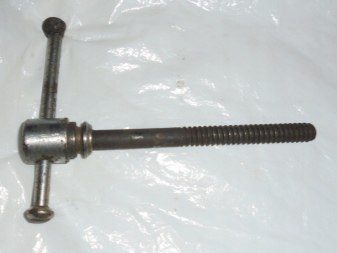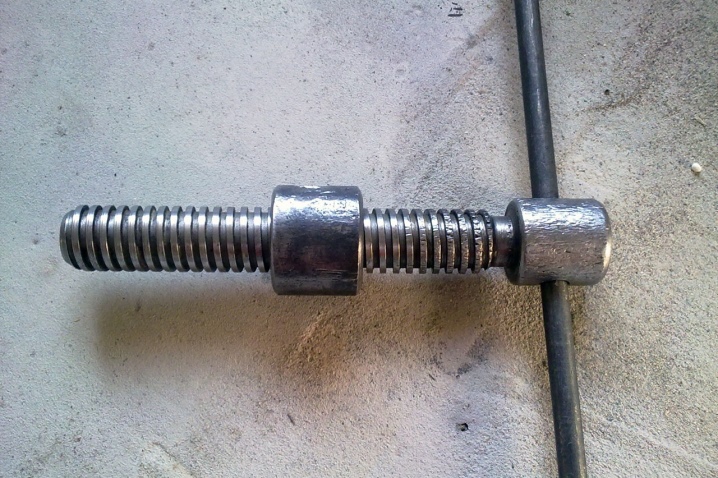Choosing a screw for a vice

Every man who performed locksmith, carpentry, drilling, hand-processed metal and wood products, probably used a vice. This means he knows how important the lead screw is. The workpiece for this technological device is made of steel and refined on a lathe. The end result is a product with the required dimensions.


Peculiarities
It is virtually impossible to make a reliable, durable vise screw at home without sophisticated equipment. Even if you have a workpiece on your hands, you will need a lathe, tools, cutters for processing parts and cutting threads of the required parameters. Therefore, if in a vice for carpentry, locksmith, bench work for any reason the lead screw breaks, you will have to look for a replacement for it or order a new one from the turner.
The device of a vice for performing work on wood, metal is reduced, in fact, to two key elements - the bed, on which the stationary jaw is installed, and the movable part, where the second clamping jaw is located. The translational-rectilinear movement of the second component with a given accuracy is ensured precisely due to the lead screw, which has a handle for convenience and to facilitate the applied force when fixing the workpiece in the jaws. Due to this design feature, parts of different sizes can be clamped between the tool jaws.
True, the size of the parts has its own limitations, which depends on the maximum distance that is specified in the design of a particular vise model.

Views
The vise itself is subdivided according to the following factors:
- by the type of drive mechanism;
- by the method of clamping the workpiece;
- according to the form of execution.


They are cross, globe, ball. However, whatever they are produced, in each model there is a screw pair, which is a travel nut that is screwed onto the central bolt (or stud) when it rotates, as a result of which the process of longitudinal movement of the movable part of the vise takes place. The central threaded rod thus unites the main parts of the device.

Men who had to deal with work in the vise probably paid attention to the profile. The trapezoidal threads used have many advantages over metric and imperial threads. Such a hairpin is resistant to increased loads, abrasion during operation. However, no less stringent requirements are imposed on the material for the manufacture of the lead screw.
The screw pair is manufactured according to the average accuracy class. In production, low-carbon steel A-40G or 45 steel is used. These alloys are easy to machine, resulting in low roughness, high profile and pitch accuracy.
The finished product has the required characteristics to ensure the proper quality of the product.


Vise lead screws are:
- with quick-release mechanism;
- with two guides to wooden workbenches;
- with emphasis;
- special - for the manufacture of L-shaped vice.


In a system where a nut, a screw and a stand are present, it is the screw that is considered the main link. It rotates in a bearing and has a smooth journal. Such a screw does not move, but forms a rotational pair.
In a rotary pair, the transformation of rotational motion into translational motion is realized. When the screw is turned, the slider, which is part of the mechanism, moves according to the thread pitch. In addition, there are other design solutions, such as a vise with a moving screw.

How to do it?
If it is not possible to purchase a finished product, then a locksmith, carpenter or home craftsman will have to order a lead screw from machine operators. In another case, when there is access to a lathe, you can make the part yourself. In this example, in addition to the machine, you will need the following materials and tools:
- blank (can be taken from steel 45);
- incisors (scoring, threaded);
- threaded templates;
- calipers;
- sandpaper to achieve minimum roughness values.


And also it is necessary to find a drawing of the lead screw and carefully read the technical parameters. If the screw is made for a certain vice, find out the diameter and pitch of the thread, so as not to be mistaken.

The part is manufactured in the following order.
- Clamp the workpiece into the lathe chuck.
- Press the workpiece on both sides and grind it under the neck to the required dimensions.
- Center the part.
- Turn over and clamp on the machined side, squeeze in the center;
- Cut to the required length.
- The last step is to cut the threads.


It is not difficult to make a lead screw with the necessary equipment and tools. The basic rule is to be able to use a lathe and sharpen cutters. And, of course, you need to know how to work with a caliper and other turning tools.

See below for how to make a vise screw.













The comment was sent successfully.